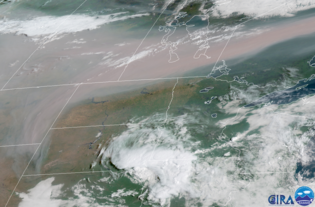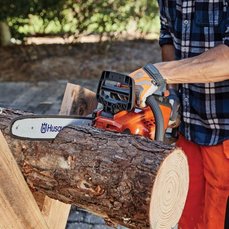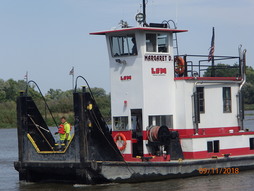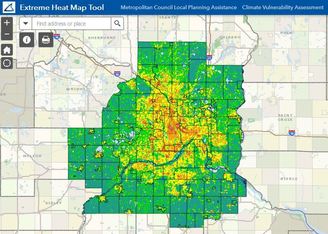|
TANKS Emissions Estimation Software, Version 4.09d is no longer supported by EPA. EPA has observed reliability issues on current Windows operating systems and anticipates further problems with the software. Because EPA is no longer supporting the TANKS 4.09d, the Minnesota Pollution Control Agency (MPCA) cannot verify emissions data from the software, so the agency will no longer be accepting emissions data using the software in permit applications. Existing, permitted tanks which were previously approved using the TANKS software will not be affected. Moving forward, permittees who are installing a new tank, changing a tank’s substance, or increasing a tank’s throughput should use the equations and algorithms from AP-42 Chapter 7 to calculate emissions from the units. These equations and algorithms can be employed with many current spreadsheet and software programs. For more information, visit the EPA’s website.
As a service to interested citizens, communities, businesses, and consultants, the MPCA’s website lists air emissions permits issued to facilities, not just the most recent permit issued to the facility, but all previous permits and technical support documents as well.
The MPCA is considering listing ONLY the most recent permit issued. Few visitors to the website access the older permits. The MPCA would remove all previously issued permits from its website. Under this proposed change, if you want to obtain a previous permit, you would need to submit an information request and potentially pay a fee for the time it takes the MPCA to gather this information.
If you have comments about this proposed change, please contact Mary Jean Fenske (maryjean.fenske@state.mn.us) by January 4, 2019.
 Fifteen years ago, the MPCA, Minnesota Chamber of Commerce, Minnesota Center for Environmental Advocacy, and Environmental Initiative came together to form Clean Air Minnesota, a public-private partnership with a mission to achieve voluntary emissions reductions. Today, the collaborative group has expanded to include a wide range of partners including local governments, businesses, and nonprofits. Together the group has implemented projects that have prevented air pollution emissions equivalent to removing nearly a million vehicles from Minnesota’s roads. Upcoming projects will cut even more. To learn more about Clean Air Minnesota, visit the group’s website.
|
 The second full summer season of air quality forecasting by MPCA meteorologists was a busy one thanks to far-away wildfires.
MPCA meteorologists kept a watchful eye over smoke and weather conditions in the early summer as wildfires began to build strength across much of the western United States and Canada. Wildfire smoke reaches the upper atmosphere and can travel thousands of miles. The question that the MPCA’s meteorologists analyze is whether the meteorological conditions will keep the smoke aloft or allow it to penetrate to the surface. Meteorologists watch for the right combination of wind direction in the upper atmosphere, combined with air mixing from the surface to several thousand feet up, cloud cover and precipitation, and consistency of the smoke to determine if it is likely to reach the surface. Smoke aloft can simply mean hazy skies and picturesque sunsets, but at ground level it can mean air quality conditions that affect Minnesotans’ health.
In 2018, the MPCA issued nine air quality alerts, in large part due to wildfire smoke transported hundreds or thousands of miles from its source. For the first time ever, an air quality alert was issued for the entire state due to the expansive clouds of smoke that were enveloping the region. The MPCA anticipates that for years to come Minnesota will continue to see air quality concerns related to distant wildfires due to ongoing climate change-related drought and heat, and to previous fire management practices that have led to accumulation of excess fuels.
The graph below shows the cause of all air quality alerts in Minnesota since 2010.
To learn more about current air quality and what you can do to protect your health, and to sign up to receive air quality alerts, visit the MPCA’s website.
|

 Tired of smelling like gas after using your gas-powered landscaping equipment? That smell is from air pollutants that can affect employee health and air quality in the populated communities the equipment serves. Up to $300,000 in grant funding is available from the MPCA to switch from old, two-cycle gas-powered equipment to electric landscaping equipment.
Using electric equipment has many benefits, including:
- No smell – Safer for employee health and more pleasant to work with.
- Lighter – Easy to use, haul, and carry across distances and multiple locations.
- Powerful – Equal performance to gas in most applications.
- Saves money – No more buying gas. Plus less maintenance.
- Safer for employees – Reduces respiratory health impacts, lessens hearing loss, eases lifting-related injuries, and reduces cuts and burns.
- Battery life – Often a short charge time, and the battery lasts for hours.
The estimated 20 million small engines sold each year in the U.S. are the largest single contributor to air pollution emissions from mobile non-road sources. The average gasoline push-mower creates nearly 15 pounds of air pollution an hour – the same as driving your car for 200 miles. Landscaping equipment emissions are not regulated and are a large contributor to bad air quality, which is why the MPCA is relying on voluntary efforts to reduce these emissions in populated areas.
Apply now! Deadline: December 5, 2018. The maximum grant amount is $24,000. The application is just two pages. Example eligible equipment includes pole saws, string or hedge trimmers, leaf and backpack blowers, lawn mowers, and chain saws.
Projects of all sizes are encouraged to apply. Find grant materials on the MPCA grants to improve air webpage. For general questions, contact Kari Cantarero (kari.cantarero@state.mn.us or 651-757-2875).
|
The Minnesota air toxics data explorer has a new look. The tool now has a monitoring-site summary page to provide an overview of each air toxics monitoring site in Minnesota. This page gives a quick look at which pollutants and health effects are of greatest concern at each air monitoring site.
Several pages have been redesigned to make it easier for users to focus on specific monitoring sites, find which air pollutants have the greatest health risks, and see how pollutant levels have changed over time. These changes make it easier for local governments and neighborhoods to find the air pollutants and sources they’re concerned about to focus on for improving air quality in their communities.
MPCA is always looking for feedback to improve our data tools. Click the green box on the right side of the data explorer tool to tell us what you think. For more information about air toxics and their sources, check the MPCA website.

The MPCA’s statewide and county air emissions inventory tool was updated with 2014 data and is available on the agency’s website. Users can explore interactive charts and data tables to view and compare statewide emissions for criteria air pollutants and air toxics. This tool allows users to explore all sources of air pollution in Minnesota including large permitted facilities, vehicles, fires, smaller neighborhood sources, and more.
For a complete list of all of the MPCA’s interactive data tools, visit the MPCA’s website.

 MPCA continues to roll out grant opportunities to replace diesel equipment and engines with new, less-polluting options using Volkswagen settlement funds.
MPCA is still accepting applications for grant funds to replace off-road diesel equipment and engines. Eligible equipment includes construction equipment, warehouse and port loading equipment, marine vessel engines, and locomotive engines. Off-road diesel engines can last a very long time and older engines can have few or no emissions controls. Replacing this equipment can achieve major emissions reductions and fuel savings, protecting the health of employees and neighbors while saving businesses money. Applications are due November 16, 2018. Learn more on the grant webpage. Upcoming grant opportunities will replace on-road trucks, buses, and other equipment.
MPCA will begin developing its plan for Phase 2 of VW funding in 2019. We will be seeking input on what is going well in Phase 1 and how we can improve it. We will hold meetings and send out surveys. Sign up to receive updates on MPCA’s Volkswagen settlement webpage.
|
 MPCA Clean Diesel Grants funded by the Diesel Emission Reduction Act (DERA) completed some unique projects in the last year.
This summer, Spectro Alloys Corp. replaced two small diesel forklifts that operate 24/7 at their busy aluminum recycling and smelter plant in Rosemount. The old forklifts were from an era of diesel technology when equipment had little or no pollution controls. The new diesel forklifts, featuring modern pollution control technology, will reduce annual fine particle emissions by one ton. EPA estimates the $24,000 grant corresponds to $600,000 in avoided health costs in Dakota County.
|
 Also, LS Marine replaced two engines in the Margaret D, a barge push-boat used in dredging river ports, operating 12 hours a day spring through fall. Replacing these engines cut fine-particle pollution from the vessel by about 80%. Learn more about the project and its benefits with this short video.
|
MPCA has been operating two air monitors in an industrial area of North Minneapolis west of the Lowry Avenue Bridge since 2014. A third monitor was added in the Bottineau neighborhood east of the Mississippi River in 2017.
The two monitors on the west side of the river have repeatedly tracked exceedances of the state standard for total suspended particulates. In addition, these monitors have shown air concentrations of metals including nickel, chromium, cobalt, and arsenic that exceed long-term health guidelines. Formaldehyde concentrations, which are high throughout the Twin Cities and in many other urban areas, also exceed long-term health guidelines.
The monitor on the east side of the river in the Bottineau neighborhood shows concentrations of air pollutants are much lower there than west of the river and do not exceed state standards or health guidelines, except for formaldehyde. The Bottineau results suggest the elevated pollutant concentrations are local to the industrial area west of the river.
MPCA is taking action to improve air quality in the area. Northern Metal Recycling has stopped operating its metals recovery plant and must stop operating its metal shredder at its Minneapolis facility by August 1, 2019 as part of a court settlement with MPCA and the city of Minneapolis. Other facilities in the area have taken voluntary actions to improve air quality, including a recent announcement by GAF, a manufacturer of shingles and roofing materials just north of the Lowry Bridge, that it plans to install a regenerative thermal oxidizer at its facility by 2020, which is expected to significantly reduce its emissions.
MPCA will continue to monitor air quality in the area and take further action as necessary to improve air quality there to acceptable levels. For more information about air quality in North Minneapolis, check the MPCA’s website.

 This summer, a Minnesota Technical Assistance Program (MnTAP) intern worked with 15 apartment complexes, small businesses, and office buildings in Minneapolis’s Phillips community to improve air quality and community health by switching to safer janitorial products. MnTAP provided samples of products with lower levels of hazardous air pollutants (HAPs) and volatile organic compounds (VOCs). If the company liked the alternative products and agreed to switch, MnTAP also provided a larger quantity of the new project to aid in the transition. A total of 26 products were switched at 11 companies, replacing 2,730 pounds of cleaning product with safer alternatives annually. These moves will eliminate 105 pounds of HAPs and 155 pounds of VOCs each year.
|
 The products most commonly replaced with safer alternatives were toilet cleaners, glass cleaners, and bleach. Toilet cleaners often contain hydrochloric acid, which is a HAP. Manufacturers of many glass cleaners do not disclose their ingredients, which may hide unsafe materials. Bleach is a common disinfectant that is a chemical irritant linked to asthma.
In addition to working with businesses, the intern also prepared informational handouts in both English and Spanish to raise awareness of safer cleaning products and where to buy them in the Phillips community. These were distributed to the public by apartment managers and community organizations and at a booth at the Lake Street Open Streets event. For more information, visit the MnTAP website.
|
 The Metropolitan Council recently released a new tool called Keeping Our Cool: Extreme Heat in the Twin Cities Region that explores how extreme heat affects the Twin Cities area. This tool is part of the Council’s regional Climate Vulnerability Assessment project. The CVA project includes tools and resources for local communities as well as analysis of Council systems and assets. The resources include potential implementation strategies and interactive mapping tools to help communities plan for resiliency.
The webpage features:
Additional CVA analysis and content is still in development. Also, check out this Planetizen story on the project.
|
In August, EPA announced a new rule proposal that would replace the Clean Power Plan which required carbon dioxide emissions reductions from existing fossil fuel-fired power plants. Called the called the Affordable Clean Energy Rule, the proposal would require states to assess the potential for efficiency improvements at their coal-fired power plants. The proposal does not set national emission reduction standards, is much narrower than the Clean Power Plan, and would result in much less emissions reductions.
The MPCA, Minnesota Department of Commerce, and Minnesota Department of Health provided comment on this rule proposal. The agencies strongly oppose the proposal and expressed concerns about its impacts on public health and the environment, as well as the energy sector. Read the agencies’ comments on Regulations.gov. EPA’s proposal can be found on their website.
Since 2017, EPA has taken a series of actions that affect how the agency reviews scientific research that informs the development of health and environmental regulations. EPA’s latest actions were to propose dissolution of both its Office of the Science Advisor (read more here), which in the past has advised the EPA administrator on the most recent scientific research, and its Particulate Matter Review Panel (read more here), which focuses on health and environmental impacts of particle pollution.
In 2017, EPA banned any member of any EPA federal advisory committee from receiving EPA grants. This requirement was intended to reduce conflicts of interest; however, it has also made it harder for academic researchers to participate on scientific advisory boards because they often rely on EPA grants to fund their research (learn more here). Now, the seven-member Clean Air Scientific Advisory Committee, a panel that is required by law to advise EPA in scientific matters related to air quality, has only one academic researcher.
Many groups have expressed concerns that these changes may make ambient air quality updates a more lengthy process and dilute the ability of the EPA to incorporate the most up to date scientific studies into its rules and guidance. Learn more at Bloomberg News.
EPA and the National Highway Traffic Safety Administration released a new proposal to replace fuel economy standards for light-duty vehicles that were finalized under the Obama administration. The proposal would freeze the standards at 2020 levels through 2026 rather than continuing to require improvements over that timeframe. It would also revoke California’s ability to set more stringent vehicle greenhouse gas (GHG) standards and electric vehicle requirements, and withdraw states’ abilities to adopt California’s standards. Fuel economy standards reduce emissions of both GHGs and other air pollutants. These regulations are critical for protecting the health of communities exposed to vehicle pollution and to achieving the GHG emission reduction goals of Minnesota’s Next Generation Energy Act.
After the close of the original comment period, EPA reopened the comment period through November 30, 2018. The MPCA, Minnesota Department of Transportation, and Minnesota Department of Health already provided comment during the original comment period. The agencies strongly oppose loosening these standards. The Minnesota Attorney General, on behalf of the MPCA, has joined a lawsuit to halt the rollback of these standards. Read the agencies’ comments on Regulations.gov. EPA’s proposal can be found on their website.
On June 26, 2018, EPA published a notice titled “Call for Information on Adverse Effects of Strategies for Attainment and Maintenance of National Ambient Air Quality Standards (NAAQS).” The NAAQS are federal air quality standards that are set to protect human health and the environment. Areas of the country are identified as either meeting or not meeting these standards. Areas that do not meet the standards must take action to come into compliance with them. The notice requests information, particularly peer-reviewed studies, on any known negative impacts on public health, welfare, energy production, or the economy of strategies and permitting requirements used to come into compliance with the NAAQS. The NAAQS are reviewed every five years to ensure they are protective of human health and the environment based on the best and most recent scientific information. EPA plans to use the information received as part of this notice to facilitate upcoming reviews of the NAAQS.
The MPCA provided comments emphasizing that health-based standards must be set considering only the most up-to-date science on health and environmental effects of air pollution, and cannot consider implementation costs. The MPCA noted that implementation costs can and should be weighed in developing plans for complying with the NAAQS, but this is the responsibility of the states, not EPA. Read the MPCA’s comments on Regulations.gov. Read EPA’s request for information in the Federal Register.
Air Mail is a quarterly, email-based newsletter featuring updates on air quality issues and the work of the MPCA and our partners. Subscribers to this list also receive Air Mail Bulletins, which provide time-sensitive regulatory and technical updates.
To see past issues, Air Mail Bulletins, or to subscribe, visit the MPCA's website.
If you have questions or comments about Air Mail, please contact Amanda Jarrett Smith at amanda.smith@state.mn.us.
|